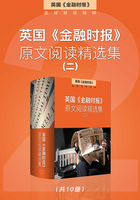
英国《金融时报》原文阅读精选集 Vol.11
中国对美国进口血浆的需求日益增长
中国是肝病大国,世卫组织的数据表明每13个中国人中就有一人受到慢性肝炎的困扰。但受到上世纪河南艾滋病事件、以及种种市井流言的影响,很少有人愿意献血。血浆的缺乏为肝病的治疗带来了困扰。
测试中可能遇到的词汇和知识:
protein蛋白质的['prəʊtiːn]
stigma耻辱,污名['stɪɡmə]
plasma血浆['plæzmə]
chronic长期的,慢性的['krɒnɪk]
hepatitis肝炎[ˌhepə'taɪtɪs]
elixir长生不老药[ɪ'lɪksə(r)]
undercut廉价出售[ˌʌndər'kʌt]
coax哄,诱骗[kəʊks]
pharmaceutical药物的[ˌfɑːrmə'suːtɪkl]
阅读马上开始,建议您计算一下阅读整篇文章所用的时间,对照下方的参考值就可以评估出您的英文阅读水平。

China liver problems boost demand for US blood plasma(587 words)
By Tom Hancock
An unlikely transpacific trade in human blood plasma products is flourishing between the US and China, where a spate of liver diseases has driven up demand for a protein contained within the vital fluid.
Chinese patients last year consumed about 300 tonnes of serum albumin — the main protein component in human plasma — roughly half of the global total, according to analysts. About 60 per cent of that was imported, and demand is growing at 15 per cent annually.
Naturally produced by the liver, the protein can be harvested by “fractionation” of donated plasma, the liquid part of human blood. Donors in the US are typically paid a fee.
However, a stigma attached to paid plasma collection in China following a string of scandals means that the country relies on imports, driving up sales for overseas exporters.
Prices in China have increased to Rmb430 ($64) for 10 grammes since a state-specified cap of Rmb378 was abolished in 2015, meaning the domestic market is worth about $1.9bn a year.
“One reason for the high Chinese consumption is that it's a major country for liver disease,” said Zhang Tong, an analyst at brokerage China Merchant Securities. About 100m — or one in every 13 people in China — has some form of chronic hepatitis, according to the World Health Organization, putting them at high risk of developing cirrhosis and liver cancer.
Widespread misconceptions about blood injections as an elixir of youth have also boosted Chinese demand. “Some Chinese people have an unscientific idea that human albumin is a nutritious product, and some wealthy or privileged consumers such as retired officials demand it,” said Xu Xianming, an administrator at a Shanghai hospital.
A reluctance by Chinese to donate blood was fuelled by a 1990s scandal that saw tens of thousands of farmers in Henan province — who had been paid to provide blood and plasma — contract HIV from unsanitary needles. The scandal was subsequently covered-up by officials.
China collected about 7,000 tonnes of plasma last year — less than a quarter of the 31,000 tonnes collected in the US. That has pushed up the price of domestic production, and Chinese albumin suppliers have been undercut by overseas rivals. Australia's CSL is the leading overseas producer with a 36 per cent share of China's imports, according to China Merchants Securities, with Baxalta of the US and Grifols of Spain taking 32 per cent and 20 per cent shares respectively. All three companies have the majority of their plasma collection centres in the US.
CSL reported 35 per cent annual growth in Chinese albumin sales in 2016, and is targeting sales of $600m from the country this year. “Plasma product demand is growing faster than supply,” said Ben Yang, China general manager for CSL's US subsidiary CSL Behring. CSL this year bought an 80 per cent stake in Chinese plasma fractionator Wuhan Zhongyuan Ruide Biologics for $352m, giving it access to the fast-growing market for other plasma products such as the market for immunoglobulin, imports of which are currently not allowed by Beijing.
Mr Yang acknowledged the challenge of coaxing Chinese people to donate, but said prices for albumin would remain high, while immunoglobulin would see “some pricing upside”.
One factor that could bring down prices is a plan to bypass donation. Last month China's top pharmaceutical administration threw its weight behind a $29m research programme to grow human serum albumin by transplanting it into rice seeds. The agency said initial trials had shown the method was “safe and effective”.
请根据你所读到的文章内容,完成以下自测题目:
1.What is serum albumin according to the article?
A.The main protein component in human plasma.
B.Liquids originating from inside the bodies of living people.
C.A component of blood whose function is to stop bleeding.
D.Cells of the immune system that are involved in protecting the body.
答案
2.Which of the following is not a reason why serum albumin in China relies on imports?
A.China is a major country for liver disease with about 100m has chronic hepatitis.
B.Chinese people have a widespread misconceptions about blood injections.
C.A string of scandals in 1990s makes Chinese people reluctant to donate blood.
D.Privileged people in China use human albumin as a nutritious product.
答案
3.Which biotechnology company holds the largest share of China's serum albumin imports ?
A.Grifols of Spain.
B.Actelion of Switzerland.
C.CSL of Australia.
D.Baxalta of the US.
答案
4. Which of the following statements is FALSE according to the article?
A.One in every 13 people in China has some form of chronic hepatitis.
B.China's demand for serum albumin is growing at 15 per cent annually.
C.China has abolished a state-specified cap of Rmb378 on paid plasma collection.
D.China has lifted its ban on imports immunoglobulin in 2016.
答案